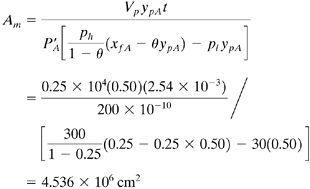13.5. COMPLETE-MIXING MODEL FOR MULTICOMPONENT MIXTURES
13.5A. Derivation of Equations
When multicomponent mixtures are present, the iteration method of Stern et al. (S1) is quite useful. This method will be derived for a ternary mixture of components A, B, and C. The process flow diagram is the same as Fig. 13.4-1, where the feed composition xf is xfA, xfB, and xfC. The known values are
![]()
The unknown values to be determined are
![]()
These eight unknowns can be obtained by solving a set of eight simultaneous equations using an iteration method. Three rate-of-permeation equations similar to Eq. (13.4-3) are as follows for components A, B, and C:
Equation 13.5-1
![]()
Equation 13.5-2
![]()
Equation 13.5-3
![]()
The three material-balance equations similar to Eq. (13.4-9) are written for components A, B, and C:
Equation 13.5-4
![]()
Equation 13.5-5
![]()
Equation 13.5-6
![]()
Also, two final equations can be written as
Equation 13.5-7
![]()
Equation 13.5-8
![]()
Substituting xoA from Eq. (13.5-4) into Eq. (13.5-1) and solving for Am,
Equation 13.5-9

For component B, Eq. (13.5-5) is substituted into Eq. (13.5-2), giving
Equation 13.5-10

Rearranging Eq. (13.5-10) and solving for ypB,
Equation 13.5-11
![]()
In a similar manner Eq. (13.5-12) is derived for ypC:
Equation 13.5-12
![]()
13.5B. Iteration Solution Procedure for Multicomponent Mixtures
The following iteration or trial-and-error procedure can be used to solve the equations above:
1. | |
2. | |
3. | |
4. | |
5. | The sum Σn
ypn is calculated from Eq. (13.5-7). If this sum is not equal to 1.0. steps 1 through 5 are repeated until the sum is 1.0. |
6. |
EXAMPLE 13.5-1. Design of Membrane Unit for Multicomponent MixtureA multicomponent gaseous mixture having a composition of xfA = 0.25, xfB
= 0.55, and xfC = 0.20 is to be separated by a membrane with a thickness of 2.54 X 10-3 cm using the complete-mixing model. The feed flow rate is 1.0 × 104 cm3 (STP)/s and the permeabilities are Solution: Following the iteration procedure, a value of ypA = 0.50 is assumed. Substituting into Eq. (13.4-2) for step 2,
Using Eq. (13.5-9), the membrane area for step (3) is
Following step 4, the values ypB and ypC are calculated using Eqs. (13.5-11) and (13.5-12): 
 Substituting into Eq. (13.5-7),
For the second iteration, assuming that ypA = 0.45, the following values are calculated:
The final iteration values are Am = 3.536 × 106 cm2; ypA = 0.4555, ypB = 0.4502, and ypC = 0.0943. Substituting into Eqs. (13.5-4), (13.5-5), and (13.5-6),
|





